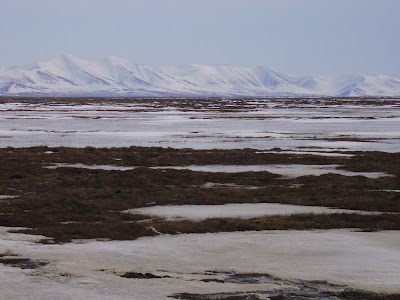
We were all pretty confident about our chances of making it back from this flight- but we took pictures of each other just in case...

Here's Carl giving us our take-off directions. "Fasten your seatbelts and don't try to open the doors when in-flight!"

As you can see we had a beautiful day to fly. Our Trip to Quinhagak was about 65 miles and took about 50 minutes. We flew at about 2000 feet. All we could see in any direction was frozen tundra and rivers of ice...






That is the Pacific Ocean on the horizon in the picture below (but, no, we could not see Russia)



Below is an aerial view of Quinhagak. The landing strip is in the upper righthand corner and it was a 2 mile drive into town. The Head Start center was in a building near the public school- The school is the larger dark building just above where the road from the landing strip meets the main road in town.

This was the view from the landing strip out across the tundra.
Here is the local staff person who took me on a home visit. She speaks English and Yup'ik, has lived in Quinhagak all her life and loves her job. (and I wish I could remember her name!)

This is the main road in town-leading away from the school. Snowmobiles and four-wheelers are the main mode of travel on town although we were taken to and from the airstrip in pickup trucks. This is a typical residential street in Quinhagak. The houses are on stilts because of the permafrost. They have to be re-leveled every few years. Plumbing is just coming to this street- they run the water and sewer lines through above-ground metal conduits. The main lines were inplace but the homes are not yet hooked up. For now the families dump their 'honeybuckets' into 55-gallon drums located around the town.

I visited the brown home in this picture. The family of 6 has electricity, oil heat, satallite tv, cell phones and a microwave. AND they depend on subsistance-meaning they live off what the land can provide. During the home visit the mom was plucking and gutting 40 Ptarmagin birds that her husband and son had shot the day before. After they were skinned they were tied in pairs and hung outside to dry. They also dry fish fillets and caribou meat that way. In the summer they gather berries.

We returned to Bethel later in the afternoon. Here is an aerial shot of Bethel

This is the main road in town-leading away from the school. Snowmobiles and four-wheelers are the main mode of travel on town although we were taken to and from the airstrip in pickup trucks. This is a typical residential street in Quinhagak. The houses are on stilts because of the permafrost. They have to be re-leveled every few years. Plumbing is just coming to this street- they run the water and sewer lines through above-ground metal conduits. The main lines were inplace but the homes are not yet hooked up. For now the families dump their 'honeybuckets' into 55-gallon drums located around the town.

I visited the brown home in this picture. The family of 6 has electricity, oil heat, satallite tv, cell phones and a microwave. AND they depend on subsistance-meaning they live off what the land can provide. During the home visit the mom was plucking and gutting 40 Ptarmagin birds that her husband and son had shot the day before. After they were skinned they were tied in pairs and hung outside to dry. They also dry fish fillets and caribou meat that way. In the summer they gather berries.

We returned to Bethel later in the afternoon. Here is an aerial shot of Bethel













